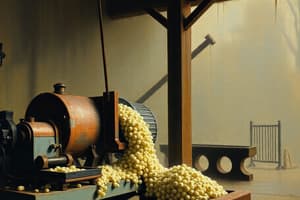Podcast
Questions and Answers
Which type of mixer utilizes an impeller fixed within a stationary shell to facilitate mixing?
Which type of mixer utilizes an impeller fixed within a stationary shell to facilitate mixing?
- Rotating shell mixer
- Fluidised bed mixer
- Fixed shell mixer (correct)
- Tumbler mixer
What is the primary mixing action employed in fixed shell mixers?
What is the primary mixing action employed in fixed shell mixers?
- Gravitational mixing
- Turbulent mixing
- Diffusive mixing
- Convective and shear mixing (correct)
Which of the following is NOT a common shape for rotating shell mixers?
Which of the following is NOT a common shape for rotating shell mixers?
- Cuboidal
- Spherical (correct)
- Drum
- Conical
What is a key characteristic of a V-shaped blender's mixing pattern?
What is a key characteristic of a V-shaped blender's mixing pattern?
How are raw materials typically loaded into a V-shaped blender to take advantage of its mixing pattern?
How are raw materials typically loaded into a V-shaped blender to take advantage of its mixing pattern?
What is the purpose of metal rods or 'baffles' within a tumbler mixer?
What is the purpose of metal rods or 'baffles' within a tumbler mixer?
Which of these mixers utilizes an Intermediate Bulk Container (IBC) as its mixing vessel?
Which of these mixers utilizes an Intermediate Bulk Container (IBC) as its mixing vessel?
Which type of mixing equipment primarily uses convective and shear mixing?
Which type of mixing equipment primarily uses convective and shear mixing?
Flashcards
Fixed Shell Mixer
Fixed Shell Mixer
A type of mixer where a fixed shell is used with an impeller (like a ribbon or paddle) that rotates, causing a mix of materials to be lifted, rotated, and dispersed in a random manner.
Rotating Shell Mixer
Rotating Shell Mixer
A mixer that uses a rotating shell, like a tumbler or drum, to mix materials. Various shapes are available, including cubic, drum, and cone.
Ribbon, Nauta, and Paddle Mixers
Ribbon, Nauta, and Paddle Mixers
A type of mixer that uses a fixed shell with a rotating impeller designed to lift and distribute materials. Ribbon mixers, Nautamixers, and simple Paddle Mixers are examples.
V-Mixer
V-Mixer
Signup and view all the flashcards
Asymmetric Drum Mixer
Asymmetric Drum Mixer
Signup and view all the flashcards
Tumbler Mixer with Baffles
Tumbler Mixer with Baffles
Signup and view all the flashcards
Fluidized Bed Mixer
Fluidized Bed Mixer
Signup and view all the flashcards
Cube Mixer
Cube Mixer
Signup and view all the flashcards
Study Notes
Mixing Equipment
- Solid/Solid Mixing
- Fixed Shell Mixers: Impeller (e.g., ribbon or paddle) rotates within a fixed shell, lifting, rotating, and distributing material randomly. Mixing is convective and shear-driven for rapid coarse dispersion, with a diffusive element for a thorough mix. Includes trough, ribbon, and paddle mixers.
- Rotating Shell Mixers/Tumbler Mixers: Wide variety of shapes (e.g., cuboidal, drum, cone) and a variety of sizes is available. IBCs (Intermediate Bulk Containers) may be used as mixing vessels. More complex designs cause material movement in multiple planes for rapid mixing. Material is often loaded in layers rather than side-by-side. Metal rods (baffles) increase mixing and reduce dead space; Intensifier bars can be utilized for greater shear, and to potentially introduce liquid. Effective mixing mechanism is diffusion, and suitable for free-flowing and granular materials; not strongly aggregating materials.
- Fluidized Bed Mixers: Uses a high-velocity air stream from below to fluidize a bed of powder. Mixing, coating, and drying can be done in a single unit. Mixing is rapid (1-2 minutes). Problems may occur if low turbulence causes segregation of particles with different sizes.
Liquid/Liquid Mixing
- Miscible Liquids: Agitation using impellers (paddles, propellers, turbines) increases mixing rate.
- Regions of Intense Shear: Impeller creates high velocity disturbances throughout the mixing vessel; avoid unmixed regions (dead zones).
- Three Different Flow Types:
- Radial: Perpendicular to the impeller shaft.
- Longitudinal/Axial: Parallel to the impeller shaft.
- Tangential: Circular path around the impeller.
- Immiscible Liquids: Surface active agents stabilize the dispersed phase, high shear rates break up the dispersed phase.
Paddle Mixers
- Large paddles, rotating slowly (10-100 rpm).
- Primarily tangential flow. Baffles can improve mixing.
- Types include simple, gate, stationary, and anchor paddle mixers.
Propeller Mixers
- Smaller than paddles, used at a wide range of speeds
- Primarily axial and tangential flow; vortex reduction by offset mounting.
- Suitable for large-scale operations, potentially horizontally mounted on the side of the mixing vessel.
Turbines
- Intermediate size between paddles and propellers.
- Effective over a wide range of viscosities.
- Primarily radial and tangential flow.
- Baffles can reduce tangential flow; shrouded turbines are more expensive.
Homogenisers
- Emulsifying immiscible liquids.
- High-speed rotor draws materials into the workhead, subjects them to mechanical shear, followed by hydraulic shear as the product circulates. Progressive reduction in globule size and homogeneity is a result. Homogeneity is accomplished by rapid circulation of the vessel contents.
Solid/Liquid Mixers
- Selection: Depends on liquid-to-solid ratio and density difference between phases, including rate of solid sedimentation
- Small amounts/low density difference: Paddles.
- Higher density/viscosity/concentration: Turbines may be more useful.
- High solids proportions: Planetary mixers, sigma or z-blade mixers.
Planetary Mixers
- Mixing elements rotate about the entire mixing chamber.
- Allows thorough mixing in all parts of the mixture.
Sigma Blade and Z-Blade Mixers
- Two opposing blades rotate in opposite directions.
- Creates kneading, folding, stretching action.
Studying That Suits You
Use AI to generate personalized quizzes and flashcards to suit your learning preferences.



